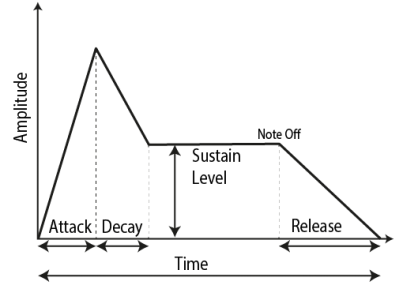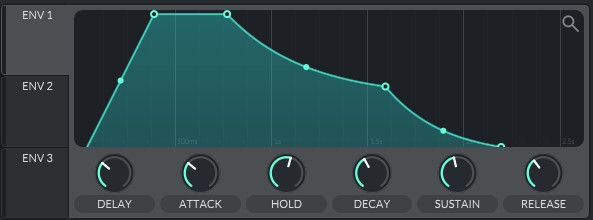Envelopes
As a music producer, you’ve probably encountered the term: ‘envelope‘ before. An envelope is a modulation source, just like an LFO. They modulate something else entirely, like the amplifier volume or filter cutoff.
ADSR Envelope Generator

The most widely used type of envelope generator is the ADSR envelope generator. ADSR stands for attack, decay, sustain, and release. A trigger is generated every time you press a note on your keyboard. This trigger starts the envelope and activates the attack time. The attack time is the time it takes for the sound to travel from off to fully on. So this allows us to create volume swells.
After the attack time is finished, the decay time follows, which is the time it takes to lower the volume to the sustain level.

The sustain level is the volume level that the note is held at when you press and hold a key. The sound keeps playing as long as you don’t release the key. When you do release the key, the release phase begins. The release time is the time between the sustain phase and the off state. So in short, the volume goes up with the attack phase, down with the decay phase, stays put in the sustain phase, and goes down again with the release phase.
Modulation Destination
Most synthesizers have two or more envelopes. One that controls the amplifier volume and another that controls the filter cutoff frequency. Envelope 1 is typically tied to the amplifier volume on most synthesizers.
By using an attack time of zero, decay time of zero a high sustain amount, and a short release on envelope 1, you get a steady sound, almost like an on-off switch.

controlling Filter Cutoff
If you now use an attack time of zero, a sustain amount of zero, a release time of zero but a short decay time on the filter envelope, you’ll get a percussive sound when the filter cutoff knob is closed.
Remember that the manual filter cutoff knob still functions, the filter envelope controls the filter cutoff frequency by what is called the envelope amount. This setting ranges from -100% to 100% and is added or subtracted from the manual cutoff position.
A positive envelope amount makes the filter cutoff go up while a negative value makes the filter cutoff go down. So if you set the manual filter cutoff halfway up and the envelope amount to 100% the envelope will open up the filter cutoff fully and then lower it again to the current position of the cutoff knob.
In other words, the filter cutoff position is the center position and the envelope amount adds an offset.
Of course the ADSR curve is just one example. Some synthesizers feature additonal stages like a delay stage or separate Hold control that sits in-between the attack and decay stages.

Some synthesizers like the Yamaha DX7 even have multiple decay stages, while others only have one attack and decay stage.
So to recap everything. An envelope modulates a knob over time. Whatever knob you control is entirely up to you. That’s the beauty of synthesizers. You can turn a simple oscillator into a complex soundscape with only a handful of tools.

